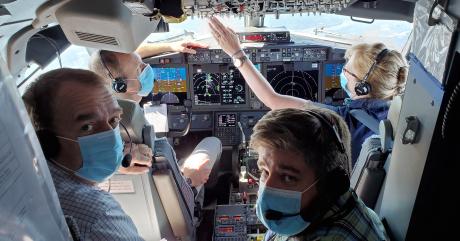EASA、737MAXの飛行試験を完了し、合同評価委員会を開催へ | EASA Completes MAX Flight Testing, Joint Evaluations Up Next

EASAはボーイング737MAXの飛行試験を完了し、次は9月後半の合同評価委員会において、改訂された訓練方法の内容を検証する予定だ。
今回の試験はカナダのバンクーバーで実施され、ボーイング737-7の開発機、1E001号機を用いて行われた。
EASAは9月11日に「運航再開に向けた次のステップに進むにあたり、EASAは合同運航評価委員会(Joint Operations Evaluation Board:JOEB)の開催に備え、飛行試験中に収集されたデータ等の分析を進めている」と発表した。
JOEBはアメリカ・カナダ・ヨーロッパ・ブラジルからのパイロットや当局者が出席し、9月14日から約10日間の日程で、ロンドンのガトウィック空港において開催される。この委員会では、提案されているパイロット訓練法の検証を行い、訓練カリキュラムを最小限に抑えるためにFAA主導の飛行標準化委員会(Flight Standardization Board:FSB)が取りまとめたレポートが発行される。
EASAは試験飛行の詳細については一切明かしていない。Flightradar24のトラッキングデータによれば、1E001号機は、9月10日にバンクーバー国際空港を発着する2時間27分のフライトを1回実施した。このフライトには一連の急旋回や複数回の高度変更が含まれており、これは更新された737MAXの飛行制御コンピュータ(FCC)ソフトウェアの検証内容と一致するものだ。ボーイング社は、同機の運航停止につながった2件の墜落死亡事故から得られた教訓を元に、操縦特性補助システム(MCAS)の飛行制御法を含むソフトウェアの改修を行った。
ボーイングが737MAXに必要な改修を進める上で、FAAが規制当局の筆頭として協力してきた。しかし、EASAやカナダ運輸省を含むいくつかの規制当局は、独自の調査を行うことを明らかにしている。EASAの飛行試験や、先月カナダ運輸省が実施した一連の試験は、これに伴う対応だ。
「EASAは737MAXを可能な限り早く運航再開させるために、FAAやボーイング社と密接に協力して作業を進めてきたが、安全確保が最優先だ」と同局は述べている。
当局が737MAXの運航再開を承認するにあたり、JOEBとFSBの次に必要になることは、オペレーターが守るべき手順を示す耐空性改善指令(AD)の取りまとめだ。8月にFAAはADの草案を発行しており、この中にはボーイング社により更新されたFCCソフトウェアのインストール、それぞれが近すぎると判断された配線束の調整、修正されたカリキュラムを用いた全パイロットの訓練などが含まれている。ADは現在パブリックコメントを受け付けており、期間は9月21日までだ。
これまでに130件のコメントが草案に寄せられているが、その多くは航空関係者によるものではなく、旅行で利用することから737MAXの動向に関心を持っているという人々からのものだ。その内容は、737MAXを安心して利用するには、挙げられている修正だけでは不充分だとするものが多い。
技術的な分析や追加項目の提案を含む、数少ないコメントの中にはヨーロッパの737MAXオペレーター合同グループ(Joint European Max Operators Group:JEMOG)からのものがあり、ボーイング社が修正を発表している「Airspeed Unreliable時のQRH(クイック・レファレンス・ハンドブック)チェックリスト」のさらなる修正を求めている。
ノルウェー航空・ライアンエアー・スマートウィングス・TUIなどを含む、ヨーロッパの737MAXオペレーター10社で構成されるこのグループは、「Airspeed Unreliable時のQRHチェックリスト手順の修正に伴い、オートパイロット作動指示の上に注意書きを追加することを強く推奨する。このコメントの目的は、誤った速度表示が続く間のオートパイロット作動にはリスクがあるとを示すことにある」と述べている。
JEMOGが提案するQRHへの追記内容は「オートパイロット作動後、ピッチ・ロール・対気速度を含む飛行状況が意図通りになっているか確認せよ」というものだ。
FAAは最終版のADを取りまとめるにあたり、草案に対するコメントの確認・検討を行うが、同局の運航再開計画に期限は示されていない。ボーイング社は運航再開に必要な最初の承認を年内には得られると、慎重な見方を続けつつも楽観視しており、規制当局は引き続きプロセスを推進し、各地域における商業運航の再開時期を明らかにしていくだろうと強調している。
ただし、FAA等の規制当局が2020年後半までに737MAXの運航再開を認めたとしても、年内の商業運航再開には疑問が残る。最終版のADが発行された後、オペレーターはこれに基づく何週間もの作業が必要になるからだ。各機材へのソフトウェアのインストール、飛行/整備マニュアルの改訂と承認、パイロットの訓練、路線計画や予約システムへの再統合など、航空会社は多くのタスクを抱えることになる。
以上は、Sean BroderickがAviation Dailyいた記事です。Aviation Week Intelligence Network (AWIN) のメンバーシップにご登録いただくと、開発プログラムやフリートの情報、会社や連絡先データベースへのアクセスが可能になり、新たなビジネスの発見やマーケット動向を把握することができます。貴社向けにカスタマイズされた製品デモをリクエスト。
EASA has completed Boeing 737 MAX flight testing, clearing the way for joint regulatory agency evaluations of the grounded model’s updated training later in September.
EASA’s work took place in Vancouver, Canada aboard Boeing’s 737-7 development aircraft 1E001.
“As the next step in its evaluation of the aircraft for return to service, EASA is now analyzing the data and other information gathered during the flights in preparation for the Joint Operations Evaluation Board (JOEB),” the European agency said Sept. 11.
The JOEB includes participation from Brazilian, Canadian, European, and U.S. pilots and regulators and is set to start Sept. 14 at London Gatwick Airport and last about 10 days. The board will evaluate proposed MAX training for pilots and feed an FAA-led Flight Standardization Board (FSB) report that will establish minimum training curriculum.
EASA did not release any details of the flights. Flightradar24 tracking data show that 1E001 conducted one, 2 hr. 27 min. flight that started and ended at Vancouver International Airport on Sept. 10. The flight profile included a series of tight turns and several altitude changes that would be consistent with trialing the MAX’s updated flight control computer (FCC) software. Boeing modified the software, including the maneuvering characteristics augmentation system flight control law, based in part on lessons learned from two fatal accidents that led to the model’s global grounding 18 months ago.
The FAA has been the lead regulatory agency working with Boeing on needed changes to the MAX. But several other regulators, including EASA and Transport Canada, have said they will conduct their own reviews. EASA’s test flights and a series completed last month by the Canadian regulator are part of this process.
“EASA has been working steadily, in close cooperation with the FAA and Boeing, to return the Boeing 737 MAX aircraft to service as soon as possible, but only once we are convinced it is safe,” the European regulator said.
Among the key steps left before regulators approve the MAX beyond the JOEB and FSB is finalizing an airworthiness directive (AD) detailing required steps for operators. The FAA issued a draft AD in August outlining the main steps, which include installing Boeing’s updated FCC software, modifying wiring bundles deemed to be too close together, and putting all MAX pilots through revised training. The directive is in the midst of a public comment period that runs through Sept. 21.
The draft AD has garnered 130 comments so far, mainly from people who say they are not in aviation but have an interest in the MAX because they travel. Many commenters say the proposed changes are not enough to convince them to fly on a MAX.
Among the few comments that include technical analysis or suggested additions to the proposed changes is a Joint European Max Operators Group (JEMOG) proposal to further modify the Airspeed Unreliable quick reference handbook (QRH) checklist—one of several that Boeing has proposed changing.
“Due to the revised QRH checklist sequence for Airspeed Unreliable, we recommend a caution statement should be added above the autopilot engagement instruction,” said the group, which represents 10 European MAX customers, including Norwegian, Ryanair, Smartwings and TUI. “The purpose of this statement will be to highlight to crew the risk of autopilot engagement while erroneous indications persist.”
The JEMOG’s proposed QRH addition: “After autopilot engagement verify that aircraft flight path including pitch, roll and airspeed are responding as intended.”
Comments on the draft AD will be reviewed and considered as the FAA prepares the final directive. The U.S. agency’s return-to-service plan does not include a time line. Boeing remains cautiously optimistic that initial regulatory approvals will come before year-end, but the company emphasizes that regulators are driving the process, and each agency will make its own decision on when to clear the MAX for revenue service in its airspace.
Even if the FAA and other agencies clear the MAX to fly again later in 2020, its return to revenue service in 2020 remains doubtful. Issuance of a final AD starts weeks of work for operators before they can put MAXs into their operations. Among the tasks facing airlines once MAXs are cleared: installing software on each aircraft, flight and maintenance manual updates and related approvals, pilot training, as well as integrating the models back into their networks and reservations systems.

